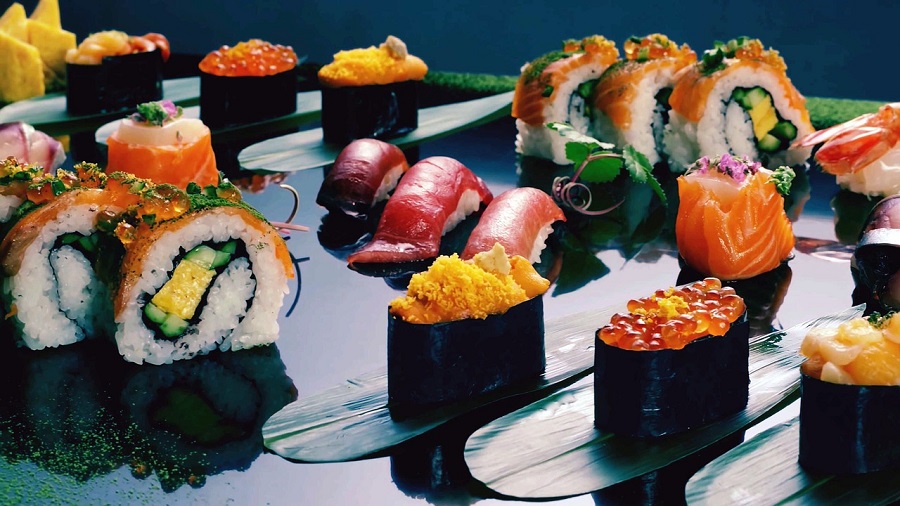I often ponder how much does a sushi roll weigh when dining out. Despite the large size of some rolls, I question if they are truly heavy. To satisfy my curiosity, I conducted research and discovered the typical weight of sushi.
Sushi is a traditional Japanese dish that has gained global popularity. It is often served in rolls, containing anywhere from 6 to 8 pieces depending on the variety. The dish typically includes a mix of raw and cooked seafood, vegetables, and rice wrapped in seaweed called nori.
Despite its small size and reputation as a healthy option, sushi rolls can be surprisingly high in calories and sodium. It’s worth noting that sushi is a broad term that encompasses different types of food, each with its own weight. In this text, I will provide information on the most popular types of sushi and their weight, so you can accurately gauge how much to order and avoid any unnecessary waste. Keep reading for more information.

How Much Does Sushi Weigh?
When it comes to sushi, it can be easy to underestimate how much you’re actually consuming. But understanding the weight of different types of sushi can help you better control your portion sizes. In this text, we’ll explore the weight of various sushi types so you can make more informed decisions about how much to order for your next meal.
The weight of a sushi piece can vary depending on the type. A single piece of maki roll sushi can weigh between 30 to 50 grams. Nigiri sushi typically weighs around 30 grams, and one piece of sashimi can weigh anywhere from 20 to 60 grams, depending on the thickness of the fish slice.
It’s worth noting that there are countless sushi recipes, and not all of them adhere to the same measurements. However, I’ve done some research to determine the most common serving sizes you can expect when ordering from a restaurant. In this text, I’ll be focusing on the following types of sushi: Maki rolls, Futomaki, Temaki rolls, Nigiri, and Sashimi.
How Big Is an Average Sushi Roll – Maki, Futomaki, and Temaki?
Maki rolls are composed of vegetables and fish, wrapped in a layer of rice and nori (dried seaweed), and rolled with a bamboo mat (makisu). Each piece typically weighs around 30-50 grams, depending on the size of the roll. One roll is usually cut into 6 or 8 pieces.
Futomaki is a larger version of maki, with up to 10 ingredients. The name “futomaki” translates to “fat rolled sushi” and it is usually about 5 to 6 cm thick, almost twice as big as maki.
Temaki, on the other hand, is a hand-rolled cone-shaped sushi consisting of nori, rice, and various ingredients that spill out from the wider end of the cone. It’s about 10 cm long, and the weight of a temaki will vary depending on the ingredients used.
Can Sushi Aid In Dieting?
It’s easy to assume that sushi’s small size and low weight makes it a great option for dieting. However, it’s important to note that the number of rolls recommended for weekly consumption is 2-3. Additionally, the calorie content of sushi can vary greatly depending on the type of sushi you choose to eat.
With several health benefits, sushi can be a healthy option due to its use of raw fish and seafood, which contain high levels of protein and omega-3 fatty acids, but it is important to be mindful of the other ingredients used. Maki rolls, for example, can contain high-calorie ingredients that can make sushi less suitable for dieting.
To provide a clearer understanding, here is a list of calorie content for popular sushi dishes per 100 grams. Keep in mind that 100 grams is approximately 2-3 pieces of sushi.
Sushi Calories per 100 g
Spider roll 214
Salmon sashimi 127
Salmon avocado roll 179
Philadelphia roll 170
Tuna nigiri 117
Cucumber roll 78
California roll 93
It’s important to note that sushi can be part of a healthy diet, but it’s important to be mindful of what you’re ordering and not to overdo it.

Some of the Popular Sushi Rolls
Pro Tip: Read my popular blog post How is Wasabi Made (Shocking Facts : 90% is FAKE!)
Avocado Roll: a vegetarian sushi dish made with avocado, pickled ginger, sesame seeds, and wasabi wrapped in seaweed. Contains 140 calories, 2 grams of protein, 24.8 grams of carbs, 3.7 grams of fat, and 20% of the daily value of sodium per 100 grams.
California Roll: made with cucumber, avocado, and cooked imitation crab (surimi) wrapped in nori. Imitation crab is made from pollock, which is low in mercury, making this roll a safer option for pregnant individuals. It is also a great option for those who want to try sushi but are hesitant about eating raw fish. Contains 93 calories, 2.9 grams of protein, 18.4 grams of carbs, 0.7 grams of fat, and 18% of the daily value of sodium per 100 grams.
Spicy Tuna and Salmon Roll: made with white rice, vinegar, avocado, cucumber, sesame seeds, and chili sauce. Contains either raw tuna or salmon. Two to three pieces (100 grams) of spicy tuna roll contains 175 calories, 7.5 grams of protein, 16.7 grams of carbs, 7.5 grams of fat, and 9% of the daily value of sodium. Two to three pieces (100 grams) of spicy salmon roll contains 190 calories, 6 grams of protein, 24 grams of carbs, 6 grams of fat, and 13.6% of the daily value of sodium.
Nigiri: This type of sushi is not rolled and is served as a thin slice of raw fish on top of a small bed of rice. Wasabi may be placed between the rice and fish, and the fish may be topped with pickled ginger. Other varieties include cooked shrimp or eel. Nigiri, like sashimi, has fewer calories than most other types of sushi. For example, 100 grams (two pieces) of tuna nigiri contains 117 calories, 15 grams of protein, 12 grams of carbs, 0.4 grams of fat, and 1.1% of the daily value of sodium.
Rainbow Roll: a more adventurous sushi dish made with imitation crab, raw seafood such as tuna, salmon, tilapia, or shrimp, avocado, cucumber, mayonnaise, and sesame seeds wrapped in seaweed and served with wasabi, pickled ginger, and soy sauce. Contains 146 calories, 7.3 grams of protein, 17 grams of carbs, 5.7 grams of fat, and 12.5% of the daily value of sodium per 100 grams.
Philadelphia Roll: made with smoked salmon, cream cheese, dill, sesame seeds, pretzel salt, and cucumber. Contains 170 calories, 7 grams of protein, 20.5 grams of carbs, 6.5 grams of fat, and 12% of the daily value of sodium per 100 grams.
Shrimp Tempura Roll: “Tempura” refers to a food that is lightly battered and deep-fried. This roll is made with shrimp that is dipped in a flour, egg, and breadcrumb batter and deep-fried, served with a tempura sauce made of soy sauce, sugar, and mirin. A great option for those who prefer cooked seafood or crispy textures. Contains 175 calories, 3.7 grams of protein, 28 grams of carbs, 5.9 grams of fat, and 17% of the daily value of sodium per 100 grams.
Dragon Roll: there are several varieties of this roll, including vegetarian options and versions made with eel. Other ingredients can include imitation crab, tempura shrimp, avocado, cucumber, and mayonnaise.
Cucumber Roll: This sushi roll is made with raw tuna, imitation crab, avocado, and radish sprouts. Cucumber rolls include a variety of sauces such as spicy chili sauce, gobo (a blend of burdock and soy sauce), and ponzu (a type of soy sauce). Contains 78 calories, 4 grams of protein, 5 grams of carbs, 5 grams of fat, and 13.3% of the daily value of sodium per 100 grams.
Salmon Avocado Roll: made with raw salmon and mashed avocado rolled with white rice, sushi vinegar, avocado, pickled ginger, sesame seeds, seaweed, and lettuce. Contains 179 calories, 5.8 grams of protein, 30 grams of carbs, 4.6 grams of fat, and 15% of the daily value of sodium per 100 grams.
Sashimi: This type of sushi is rice-free and consists of thinly sliced raw fish served with wasabi and soy sauce. Common types include tuna and salmon. It is lower in calories and carbs than most other types of sushi. For example, 100 grams of salmon sashimi contains 127 calories, 20.5 grams of protein, 0 grams of carbs, 4.4 grams of fat, and 3.2% of the daily value of sodium.
Making Sushi Healthier
Traditional Japanese sushi dishes are often low in calories due to their minimal ingredients. However, many westernized adaptations of sushi can be high in calories due to added fat and high-fat sauces. Additionally, the use of large amounts of soy sauce can increase sodium levels, which can be a concern for those with high blood pressure.
Here are some ways to make your sushi healthier:
Use alternative grains
Some restaurants offer sushi made with brown rice or quinoa instead of white rice, which can increase the fiber and nutrition content of your meal.
Choose fresh options
Freshly made sushi often has fewer ingredients than packaged sushi and is less processed.
Choose low-fat options
Tempura sushi and sushi made with mayonnaise and cream cheese are higher in calories. Opt for lower-fat alternatives.
Opt for rice-free options
Sashimi is a rice-free, low-calorie option that is perfect for those who enjoy raw fish.
Limit soy sauce
Soy sauce is high in sodium, which can be a concern for those with high blood pressure. Request soy sauce on the side and use it sparingly.
Focus on side dish
Sushi is often served with sides such as pickled ginger, wasabi, miso soup, and edamame beans. These can add variety and flavor to your meal, reducing the need for soy sauce.
Frequently Asked Questions About How Much Does A Sushi Roll Weigh
Can I make sushi with a rice cooker?
A rice cooker is a convenient tool to use for making sushi rice. It allows for an effortless and hands-free method to prepare perfectly plump and moist grains of rice, without the need to monitor boiling water or worry about overcooking. Consistent results can be achieved by accurately measuring the rice and water.
How much does a sushi roll weigh?
The weight of a sushi roll will vary depending on the ingredients used and the size of the roll. On average, most sushi rolls are made with 3 to 4 ounces of rice per roll, which adds about 140 calories and 30 grams of carbs to each roll.
How heavy is a piece of sashimi?
Sashimi is thinly sliced raw fish that is typically served on its own. The weight of sashimi will depend on the thickness of the slices. Most chefs make sashimi that is 0.5-2 ounces, with 1 ounce (about 30g) being the most common. However, sashimi can also be found in weights ranging from 20-60g.
How much does a piece of nigiri weigh?
Nigiri is a sushi dish that consists of a shaped rice ball topped with a slice of raw fish. The size of nigiri will depend on the amount of fish used, but typically one piece weighs about 30g.
How much rice is on a sushi roll?
Most sushi rolls are made with 3 to 4 ounces of rice per roll, which adds about 140 calories and 30 grams of carbs to each roll. Some sushi rolls are made with brown rice, which adds more fiber, but still has a similar amount of carbs and calories as white rice.
What is the typical size of a sushi roll?
The average size of a sushi roll is approximately 4 inches long. Sushi rolls are made by rolling paper and can be eaten with the fingers to maintain the crispness of the nori. Some sushi rolls can also be ordered in the hand roll style.
What is considered 1 serving of sushi roll?
A typical serving size of sushi roll is one or two rolls. However, it is possible to consume more than that.
What is considered 1 sushi roll?
A sushi roll typically consists of one roll, which is often served as a meal at sushi restaurants.
How much rice is required to make three sushi rolls?
Prepare 1 cup of sushi rice for 3 sushi rolls. Each roll makes up 6-8 pieces of sushi. Depending on individual preferences, 2 rolls are normally advised per person.
How many pieces is 100g of sushi?
The number of pieces in 100g of sushi will vary depending on the type of sushi and the size of the pieces. A pre-packaged dragon roll sushi with eel and imitation crab may contain 11 calories per 100 grams (2 to 3 pieces).
How big is an average sushi roll?
The size of a sushi roll will depend on the ingredients and the size of the roll. Maki rolls typically consist of vegetables and fish, covered with a layer of rice and nori, which are then rolled with a bamboo mat. Each piece of a maki sushi roll typically weighs 30-50g, depending on the size of the roll. Six or eight pieces are typically cut from a single roll.
What is the best rice for sushi?
Short-grain rice is considered the best option for making sushi. Koshikikari, a type of short-grain rice native to Japan, is widely regarded as the optimal choice for making sushi. Tamanishiki Rice is another popular option, which is grown in California and more affordable.
What are two sushi pieces?
Nigiri is a type of sushi which is crafted by shaping a ball of vinegared rice with the hands and topping it with a slice of raw fish. Normally served in pairs, it can be eaten with one’s hands.
How many pieces are in a traditional sushi roll?
A traditional sushi roll is typically cut into 6 or 8 pieces after being wrapped in a sheet of nori, filled with a layer of rice, vegetables, and fish, and rolled using a bamboo mat.
Is sushi high in carbs?
Sushi contains carbs, as it is made with rice. While sushi is a good source of nutrients and proteins, it is important to consider the carbs when consuming large amounts of sushi.
How many calories are in one sushi roll?
A typical 6-piece sushi roll contains 200 to 250 calories. The calorie count can vary depending on the ingredients and sauces used, with rolls like the avocado roll being lower in calories and rolls like the rainbow roll being higher in calories.
How much sushi is in a roll?
A sushi roll order typically consists of 6 or 8 pieces, which are cut from a roll made with a bamboo mat.
Is 8 pieces of sushi enough?
The amount of sushi that is considered enough will vary depending on the individual’s appetite and the occasion. In general, it is recommended to have 2 to 4 pieces or 6 to 8 pieces per person, but this can vary if there are other foods or a party setting.
What distinguishes a Japanese rice cooker from a standard rice cooker?
A Japanese rice cooker is differentiated from a traditional rice cooker by its steam pressurized design. A traditional rice cooker, on the other hand, typically features a light-fitting lid. The main distinction between the two types of rice cookers is their design; a traditional rice cooker typically takes the form of a simple bucket heater with a metal pot and lid.
How much sushi should I order for 4 people?
Sushi is commonly shared, which is why many sushi catering options include platters or “boats.” As a general guideline, plan on ordering about one roll (six pieces) per person for a group of four.
Why does sushi make me feel full?
Sushi, made with a variety of ingredients such as cucumber, fish or crab, and nori, is known to be filling due to the high starch content in the sushi rice. The combination of textures and flavors in sushi can also contribute to a sense of satiety.


